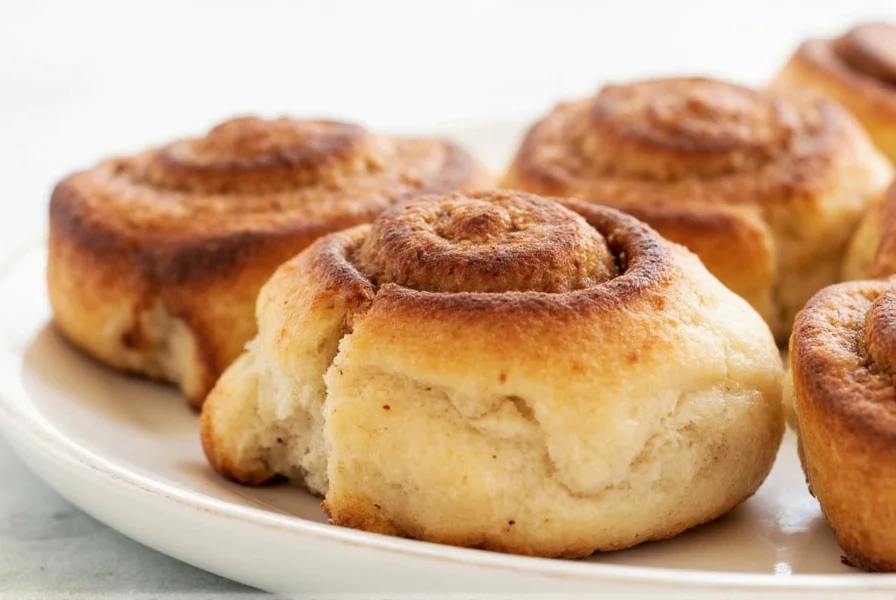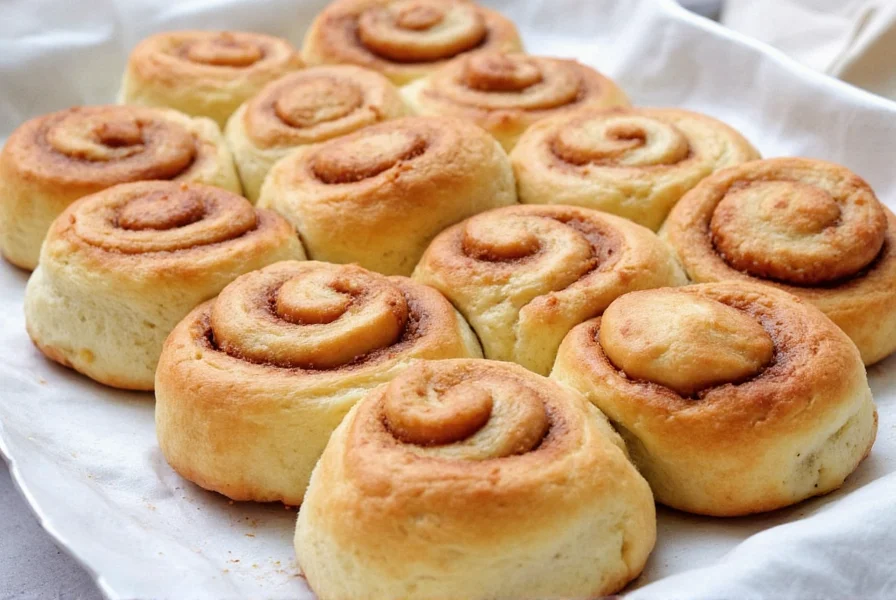The Science Behind Yeast-Free Cinnamon Rolls
Traditional cinnamon rolls rely on yeast for that signature airy texture, but yeast-free versions use chemical leaveners like baking powder and baking soda. When combined with acidic ingredients like buttermilk or yogurt, these leaveners create carbon dioxide bubbles that give your rolls lift without the lengthy rising time. This method produces cinnamon rolls with a slightly denser but still delightfully soft crumb that many prefer for their comforting texture.
Why Choose Yeast-Free Cinnamon Rolls?
There are several compelling reasons to try yeast-free cinnamon rolls. They're perfect when you're short on time since they skip the 1-2 hour rising period required for traditional recipes. They're also ideal for those with yeast sensitivities or allergies, and they work when yeast is unavailable at your local store. Many bakers find the simplified process more approachable, especially beginners who might struggle with yeast activation and dough handling.
| Yeast-Based Rolls | Yeast-Free Rolls |
|---|---|
| Requires 1.5-2 hours rising time | Ready to bake immediately |
| Delicate handling required | More forgiving dough |
| Lighter, airier texture | Slightly denser, cake-like texture |
| Traditional flavor profile | Bold cinnamon flavor shines through |
| Yeast sensitivity concerns | Suitable for yeast-free diets |
Essential Ingredients for Perfect Yeast-Free Cinnamon Rolls
The magic of yeast-free cinnamon rolls happens through careful ingredient selection. All-purpose flour provides structure while maintaining tenderness. Double-acting baking powder delivers the primary lift, with baking soda enhancing browning and flavor. Buttermilk's acidity reacts with the baking soda while adding moisture and tang. High-quality butter makes the difference in both the dough and the cinnamon filling—don't skimp here. For the filling, use a mix of brown and white sugars to create that perfect sticky-sweet texture that defines great cinnamon rolls.
Step-by-Step Yeast-Free Cinnamon Roll Recipe
Mix 3 cups all-purpose flour, 1 tablespoon baking powder, 1 teaspoon baking soda, and 1/2 teaspoon salt in a large bowl. In another bowl, whisk 1 cup buttermilk, 1/3 cup melted butter, and 1 large egg. Combine wet and dry ingredients just until a soft dough forms—overmixing leads to tough rolls. Turn onto a floured surface and gently knead 5-6 times until smooth.
Roll the dough into a 16x12 inch rectangle. Mix 1/2 cup softened butter, 1 cup packed brown sugar, 1/4 cup granulated sugar, and 3 tablespoons cinnamon. Spread evenly over the dough, leaving a 1/2 inch border. Roll tightly from the long side, pinch seam to seal, and cut into 12 equal pieces using dental floss for clean cuts. Place in a greased 9x13 inch pan and bake at 375°F for 20-25 minutes until golden brown.
Troubleshooting Common Yeast-Free Cinnamon Roll Issues
Dense rolls usually result from overmixing the dough or expired baking powder. Always test your baking powder by mixing 1 teaspoon with 1/3 cup hot water—if it doesn't bubble vigorously, replace it. Filling leakage happens when the dough isn't rolled tightly enough or when the filling is too runny. Chill the cut rolls for 15 minutes before baking to help them hold their shape. For pale tops, brush with cream before baking or add 1-2 tablespoons of milk to your icing for a beautiful golden finish.
Storage and Reheating for Maximum Freshness
Store cooled cinnamon rolls in an airtight container at room temperature for up to 2 days. For longer storage, freeze them individually wrapped in plastic wrap, then place in a freezer bag for up to 3 months. To reheat, microwave a single roll for 15-20 seconds or warm in a 300°F oven for 8-10 minutes. The oven method better preserves texture. Never store cinnamon rolls in the refrigerator—they dry out quickly due to the starch retrogradation that occurs at cold temperatures.

Variations to Customize Your Yeast-Free Rolls
Make these rolls your own with simple adaptations. For gluten-free cinnamon rolls without yeast, substitute a 1:1 gluten-free flour blend and add 1 teaspoon xanthan gum. Vegan versions work well with plant-based butter, flax egg (1 tbsp ground flax + 3 tbsp water), and coconut yogurt instead of buttermilk. Add 1/2 cup chopped pecans or walnuts to the filling for crunch, or swirl in 1/4 cup apple butter for an autumn twist. For an extra-special treat, replace some of the cinnamon with pumpkin spice or cardamom.
Why This Yeast-Free Method Works Better Than Other Substitutes
Many online recipes suggest using self-rising flour as a yeast substitute, but this often leads to inconsistent results. Our tested method balances baking powder and baking soda specifically for cinnamon rolls, creating the ideal rise without metallic aftertaste. The buttermilk provides just enough acidity to activate the baking soda while contributing to browning and flavor development. This precise ratio—1 tablespoon baking powder to 1 teaspoon baking soda per 3 cups of flour—delivers reliable results every time you make easy cinnamon rolls without yeast.
Frequently Asked Questions
Can I make overnight cinnamon rolls without yeast?
Yes, you can prepare yeast-free cinnamon rolls ahead of time. Assemble the rolls in the baking pan, cover tightly, and refrigerate for up to 24 hours. When ready to bake, remove from refrigerator while oven preheats—this 30-minute temperature adjustment prevents shocking the dough. Bake as directed, adding 3-5 minutes to the baking time if needed.
Why are my yeast-free cinnamon rolls dry?
Dry yeast-free cinnamon rolls typically result from overbaking or inaccurate flour measurement. Use the spoon-and-level method for flour (don't scoop directly with the measuring cup). Bake until the edges are golden but the center still looks slightly underdone—they'll continue cooking from residual heat. Adding 1-2 tablespoons of extra buttermilk to the dough can also improve moisture retention.
What's the best yeast substitute for cinnamon rolls?
The best yeast substitute for cinnamon rolls is a combination of baking powder and baking soda. Use 1 tablespoon baking powder plus 1 teaspoon baking soda per 3 cups of flour. This provides reliable lift without metallic aftertaste. Buttermilk or yogurt enhances the reaction while contributing flavor and moisture. Avoid single-substitute methods (like using only baking powder) as they rarely deliver optimal texture.
How do yeast-free cinnamon rolls compare to traditional ones?
Yeast-free cinnamon rolls have a slightly denser, more cake-like texture compared to the airy lightness of yeast versions. They lack the subtle fermented flavor that develops during yeast rising, allowing the cinnamon and sugar flavors to shine more prominently. The preparation is significantly faster (under 2 hours versus 3+ hours), and they're more forgiving for beginner bakers. Many people prefer yeast-free rolls specifically for their consistent texture and straightforward process.











 浙公网安备
33010002000092号
浙公网安备
33010002000092号 浙B2-20120091-4
浙B2-20120091-4